


IV. AllWISE Image Atlas
IV.4. Cautionary Notes
Contents
- Depth-of-coverage variations
- Low coverage areas and bleed-through of spurious sources
- Astrometric biases with respect to the Source Catalog
- The intensity units of Atlas Image pixels are Digital Numbers (DN)
- Background (frame-overlap) matching
- Artificial background gradients from exceptionally bright sources
- Atlas Image artifacts
- "NaNs" and "holes" from saturation-masking
- Missed (unmasked) saturation
- Saturation "expansion" relative to All-Sky Release products
- Low-flux banding artifacts
- Effective size of a "point-source" in an Atlas Image
IV.4.a. Depth-of-coverage variations
Global and local variations in the depth-of-coverage are expected from the
nominal survey design (section I.2.a.).
However, there are regions where the depth-of-coverage varies considerably
due to the exclusion of "bad" input frames and individual
pixels when generating the Image Atlas.
This could be due to contamination from the moon, cosmic rays,
and/or other outliers (e.g., induced by fast moving objects),
or bad quality frames in general. The latter
are usually associated with elevated noise or degraded image quality
caused by excursions in
spacecraft tracking. For details on the frame selection process, see section V.1.b.i. A general description of the
construction of the depth-of-coverage maps and the physical meaning of
pixel values therein is given in section II.3.d.
IV.4.b. Low coverage areas and bleed-through of spurious sources
Examples of Atlas Images with low depth-of-coverage
are shown in Figure 1. More examples are shown in
the Atlas Image Anomaly Gallery for the All-Sky Data Release.
Low coverage-depths are most prevalent in
W3 and W4 since AllWISE multiframe processing for these bands only used frames from the 4-band cryo phase of the mission.
Thus, the W3 and W4 AllWISE Atlas Image products are effectively equivalent to
those in the All-Sky Data Release.
The anomalies induced by low
depth-of-coverage regions in the All-Sky Release also apply
to the AllWISE Release for all bands.
An immediate consequence for regions with low depth-of-coverage
(covered effectively <~ 6 times) is
that the temporal pixel-outlier rejection process becomes unreliable.
Even though robust estimators were used in this method,
they are still relatively "noisy" when
the number of samples in the stack was low. Strictly speaking, no temporal
pixel-outlier rejection is performed for depths-of-coverage ≤ 4. This criterion avoided throwing away too many good pixels during the
coaddition process, with the caveat of increasing the number
of unreliable or spurious detections (cosmic rays, fast moving object trails,
and other transients).
Note that the AllWISE Source Catalog selection process explicitly excluded extractions from regions with a depth-of-coverage ≤ 4.
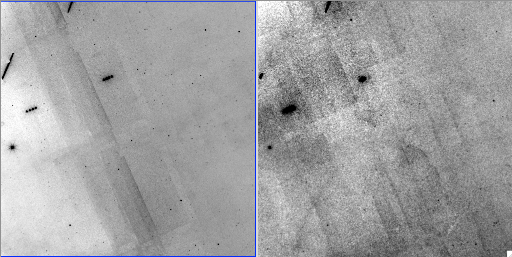 |
| Figure 1 - Example Atlas Images in W3 (left) and W4 (right)
from tile ID 1799m076_ac51 showing the bleed-through of
spurious artifacts in regions with low depth-of-coverage - in this
case moving objects and cosmic rays. Corresponding depth
maps are shown in Figure 2. |
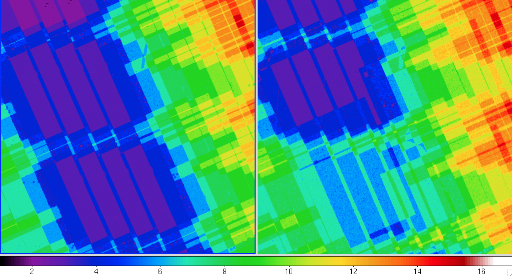 |
| Figure 2 - Depth-of-coverage maps corresponding to the
Atlas Images in Figure 1: W3 (left), W4 (right). Color-bar indicates the
approximate depth. |
IV.4.c. Astrometric biases with respect to the Source Catalog
If one were to measure the equatorial (J2000) positions of sources
off Atlas Images, e.g., via a flux-weighted centroid or peak-finding algorithm,
there could be a systematic difference with
the astrometrically calibrated
positions from the AllWISE Source Catalog.
The latter has an accuracy of ~ 0.1″ (1-σ per axis) for high S/N sources
over the sky (section II.5).
For reasons not yet understood, the
Atlas Image-derived source peak and "true" astrometric position
differences vary with
location on the sky and across bands.
The 95th percentile upper limits in the radial differences
are typically <~ 0.075″ in W1 and W2, <~ 0.43″ in W3,
and <~ 1.1″ in W4. A procedure to correct the Atlas Image-derived
source positions and/or image WCS
in general (if significant biases exist) is given in
section IV.3.b.
IV.4.d. The intensity units of Atlas Image pixels are Digital Numbers (DN)
Pixel units in the Atlas Images (and single-exposure images) are
not calibrated in terms of absolute surface brightness. Their units are
digital numbers (DN). The images are designed for photometric
measurements relative to a local background using the photometric
Zero Point Magnitude (MAGZP) provided in their FITS headers. Section IV.3.a describes how photometric
measurements on the Atlas Images in DN can be converted to
absolute flux units.
IV.4.e. Background (frame-overlap) matching
One of the first steps in the Atlas
Image generation pipeline is background
level matching of the single-exposure frames.
Since WISE had no requirements for measuring the
absolute intensity of the background,
we adopted a simple, fast, locally self-consistent method. Only the single
exposure frames touching an individual Atlas Image tile (independent of all
those touching neighboring tiles) were matched with respect to each other.
Two caveats of this method are:
- Background gradients and levels
will not be continuous across Atlas tile boundaries on the sky.
I.e., systematic "step-like" patterns will result if one attempts to
stitch together several or more tiles across the sky.
- Within an
individual tile, the method assumes the difference in levels in the
overlap region between any pair of frames is spatially constant.
This is usually a good approximation,
however, it breaks down when the background
gradient is not the same across frames in their overlap
region (i.e., that "see" the same piece of sky).
This usually occurs when the frames are contaminated
by scattered moon-light and results in step-like patterns across
frame boundaries in an Atlas Image.
IV.4.f. Artificial background gradients from exceptionally bright sources
An anomaly seen in a handful of Atlas Images is the presence of
non-astrophysical gradients in the background, in all bands. This is
another caveat of the background
frame-level matching algorithm (in addition to
those in section IV.4.e. above).
This is caused by the presence of bright sources falling on the
first (seed) frame that sets the course for matching
to all other frames falling in the co-add footprint (see algorithm for details). An example is shown in Figure 3.
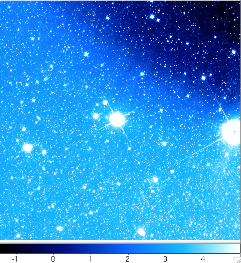 |
| Figure 3 - Example of a W1 Atlas Image
(tile ID 3107m379_ac51) with an unphysical background
gradient induced by processing. The values on
the color-bar are in DN. |
IV.4.g. Atlas Image artifacts
The Anomaly Gallery contains examples of the artifacts
commonly encountered in Atlas Images. These examples are from
the All-Sky Release Image Atlas and many of them carry over
to AllWISE.
Overall, these anomalies fall in two broad categories,
with much overlap between the two:
- Artifacts present at the single-exposure level that
are not suppressed during the co-addition process. Examples are
diffraction spikes and short-term latents.
The survey scanning strategy in general did not produce randomly dithered overlapping
frames for optimal pixel outlier detection.
Due to negligible frame rotation
around the ecliptic plane, these artifacts are seen to
reinforce most strongly there, while
they "smear-out" as one approaches the ecliptic poles.
- Transients that are most apparent
in low depth-of-coverage regions, e.g.,
cosmic rays, detector-induced
electronic-noise
(channel/amplifier noise in bands 1 & 2 or droop residuals in bands 3 & 4), light scattered from the moon
and other bright objects, glints, satellite trails, fast moving objects, and
latents generated therefrom.
It's also important to note that the AllWISE multiframe pipeline used reprocessed single-exposures from
the 4-band cryo phase (all bands) and the 3-band cryo phase
(W1 and W2 only), primarily to correct for
an instrumental calibration issue
as described in section V.2.a. Very little manual quality-assurance
was performed on the regenerated single-exposures.
The same frame quality scores from earlier frame-level QA (for the All-Sky and 3-band Data Releases) were used to determine
frame usability for the AllWISE muiltiframe pipeline.
As a consequence, some "badly" calibrated frames (not captured
by the original quality scoring) still made it through
to the muiltiframe pipeline. Their signature will also be most
noticeable in Atlas Images with low depth-of-coverage regions.
We expect this to be more prevalent in W3 and W4.
IV.4.h. "NaNs" and "holes" from saturation-masking
Saturated pixels were masked in the single-exposure frames and omitted
when constructing the Atlas Images.
For bright regions and sources exceeding
the saturation limits,
pixels in the Atlas Image
intensity and uncertainty maps will be associated with NaN
(Not-a-Number) values.
The corresponding depth-of-coverage map will have zero coverage in these
regions. These "holes" are typically seen at the location of the peak-emission
of sources that were bright enough to saturate on the detectors.
IV.4.i. Missed (unmasked) saturation
The automatic saturation tagging that occurred on board the WISE spacecraft worked rather well,
however, there were times when it was not reliable.
This occurred intermittently when the counts were at the highest end of the
dynamic range in any band. Despite workarounds to mitigate this
effect (sections IV.4.j. and VII.3.b.),
there are instances in regions
of very bright emission, including the cores of very bright sources
where saturated frame pixels (with anomalous values)
were included when constructing the Atlas Images.
The values of these pixels are generally low relative to
that expected for the region. Examples are shown in Figures 4 and 6 and is
generally seen in all bands.
Given that this also affected the single-exposures, their use in
simultaneous PSF-fit photometry also impacted
the bright source photometry as described in section II.2.c.
IV.4.j. Saturation "expansion" relative to All-Sky Release products
To mitigate the incidence of missed (unmasked) saturated pixels described
above, a spatial-expansion algorithm was implemented to ensure more complete blanketing of the suspect
saturated region. The amount of spatial expansion was rather conservative
as to not severely impact source photometry. In general, this lead
to more pixels being masked as saturated in and around the cores of
sources in the AllWISE Atlas Images relative to those in the All-Sky release.
An example is shown in Figure 4. The impact to the bright source photometry (relative to the All-Sky Release)
is described in sections V.3.a.iii.4. and II.2.c.
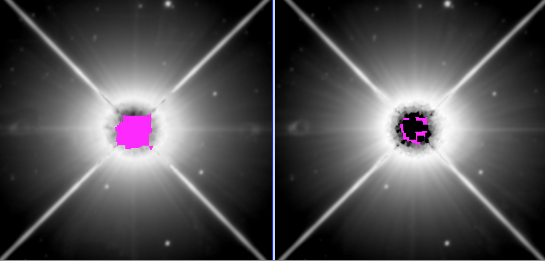 |
| Figure 4 - W1 Atlas Image zoom-ins of Betelgeuse from
the AllWISE Release (left) compared to the All-Sky Release
(right). Magenta regions represent NaN'd (zero-coverage)
regions due to saturation in all the input frames at that
location. Despite the use of a "saturation-expansion"
method for AllWISE (section IV.4.j.),
there is still an unmasked periphery of pixels around the
core. |
A related consequence of "saturation expansion" in general was noted
when visually examining image cut-outs of 80 relatively bright
motion-candidate stars during AllWISE Quality Assurance. These appeared
to have a "mottled" or "pock-marked" appearance in the AllWISE Atlas
Images, primarily in W1 and W2, that was not present in Atlas Images from
the All-Sky Release. These stars were generally
brighter than 6th-magnitude in W1 and hence well into the saturated regime. Figure 5 compares Atlas Image cut-outs from AllWISE and
All-Sky, for a typical
motion-candidate star exhibiting this phenomenon. The degraded visual
appearance of this star in the AllWISE W1 and W2 tiles resulted from the inclusion
during co-addition of relatively "warmer" single-exposures from the
post-cryo phase of the mission that were more prone to saturation.
The combination of "saturation expansion" (with greater masking of source cores),
implicit smoothing during the coaddition and pixel-interpolation process,
and temporal changes in the PSFs themselves all acted to change the overall morphology
of bright sources on the AllWISE W1 and W2 Atlas Images. The impact on the
photometry is discussed in section II.2.c.
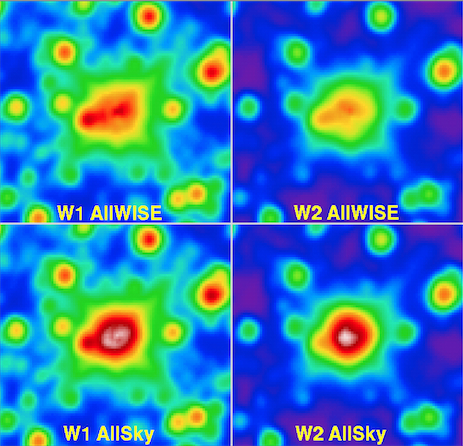 |
| Figure 5 - Atlas Image zooms centered on a star
with saturated cores in W1 and W2 from AllWISE
tile 2700m319_ac51 (top row) and the equivalent
from the All-Sky Release (bottom row). |
IV.4.k. Low-flux banding artifacts
In regions with very-bright emission, W3 and W4 Atlas Images often show
banding patterns with depressed flux. The regions need not be saturated
or close to saturation. This effect is due to inadvertently unmasked
pixel rows at the top and bottom edges of the input W3 and W4
single-exposure frames that have a relatively low
responsivity. These low-response rows were not completely captured in the
static flat-field calibration products to enable their removal since they
were slightly transient.
Given these low-response pixel rows
have a multiplicative effect on the signal
that falls on them, higher signals will suffer a
proportionally greater loss in their output counts. These
anomalously low counts fall below
the detector saturation thresholds and therefore remain unmasked.
This banding is seen in the bright regions
of the W3 and W4 Atlas Image-cutouts shown in Figure 6.
Note that the flux along a "band" could be depressed by as much as 12%
over the entire length of an Atlas Image.
Therefore, all sources or emission intercepting these bands are likely
to have a biased flux.
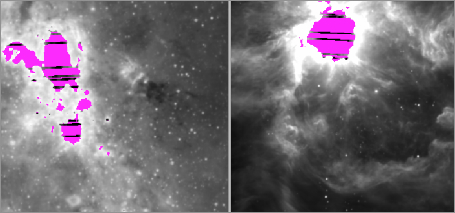 |
| Figure 6 - W3 Atlas Image zoom-ins of the Galactic
Center (left) and the core of the Orion Nebula (right).
Magenta regions represent NaN'd (zero-coverage)
regions due to saturation in all the input frames at that
location. |
IV.4.l. Effective size of a "point-source" in an Atlas Image
The effective size of the PSF in an Atlas Image is not the same as that
inferred from the single-exposure frames. For the latter,
the azimuthally-averaged FWHM of a point source profile
is ≈ 5.8″, 6.4″, 6.7″, and 11.8″
for bands W1, W2, W3, and W4 respectively
(e.g., see Table 1 in section IV.4.c.iii.1).
For Atlas Image (co-adds) however, the FWHM of a point source profile
is ≈ √2 times larger than the native (single-exposure) values,
or ≈ 8.3″, 9.1″, 9.5″, and 16.8″ in W1, W2, W3, and W4 respectively (however, see caveat below).
This additional smoothing arises from use of the native PSF
as an interpolation kernel during the co-addition process
(for details, see section IV.4.f.vii).
This includes the small inevitable amount of smoothing from
mapping onto a new grid with finite-sized pixels.
The PSF-interpolation makes the Atlas Images also serve as
match-filtered products optimized for detecting sources in the pipeline
(for details, see section IV.4.b).
The Atlas Image PSF FWHMs quoted above
are global ballpark measures and not representative of any one Atlas Image.
A "highly-homogenised" set of Atlas Image PSFs is provided in section IV.4.c.viii.
These were created
from Atlas Images at high ecliptic latitudes where the
high depth-of-coverage and large spread in
single-exposure rotations acted to circularize the PSF.
Owing to the asymmetric nature of the native PSFs (even after co-addition
for low-to-moderate depths-of-coverage),
we recommended you derive the PSF for your
Atlas Image of interest. To obtain an accurate PSF, you may need to
combine measurements from multiple Atlas Images with similar depths-of-coverage and input single-exposure geometries.
Last update: 20 November 2013











